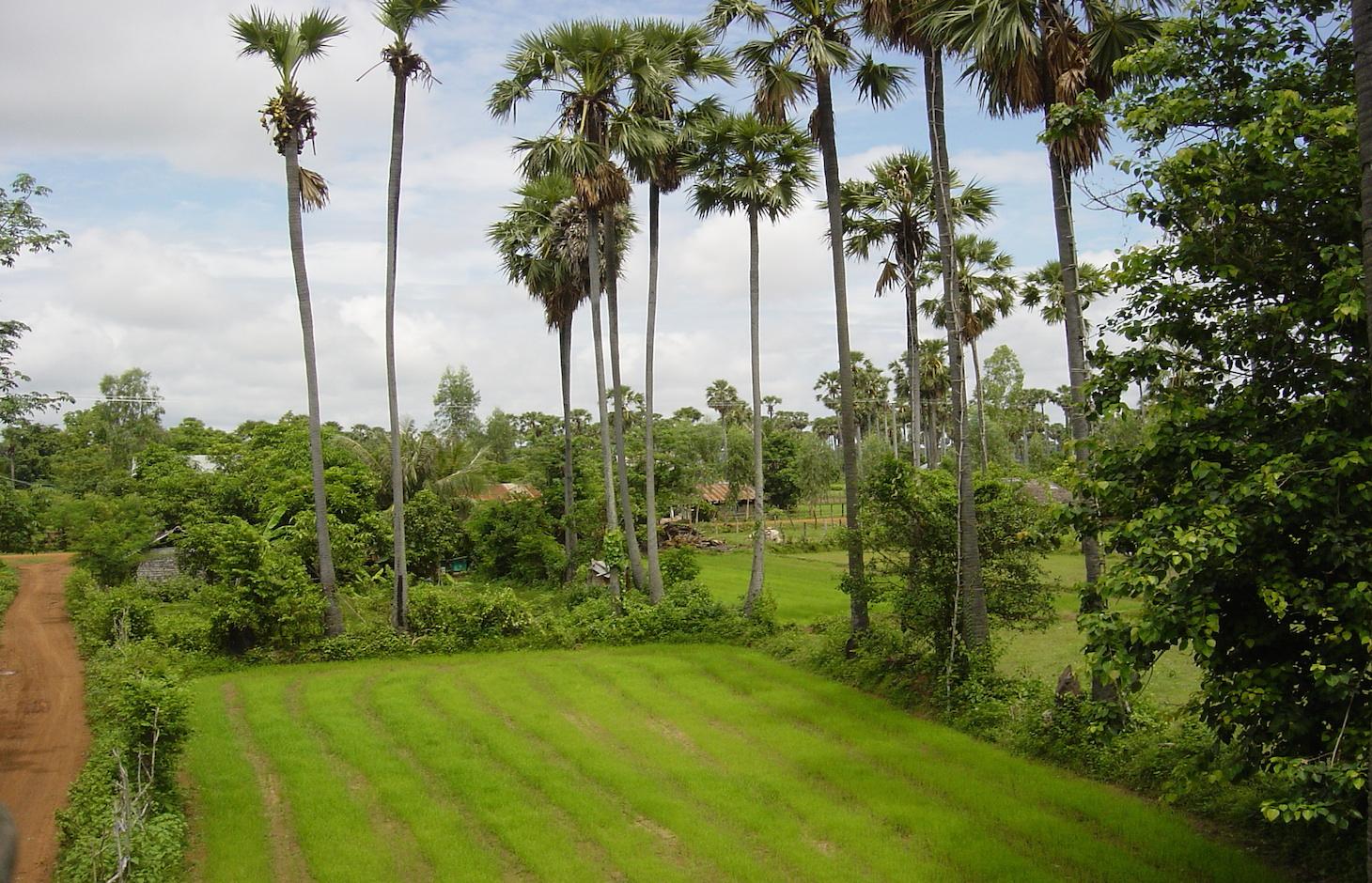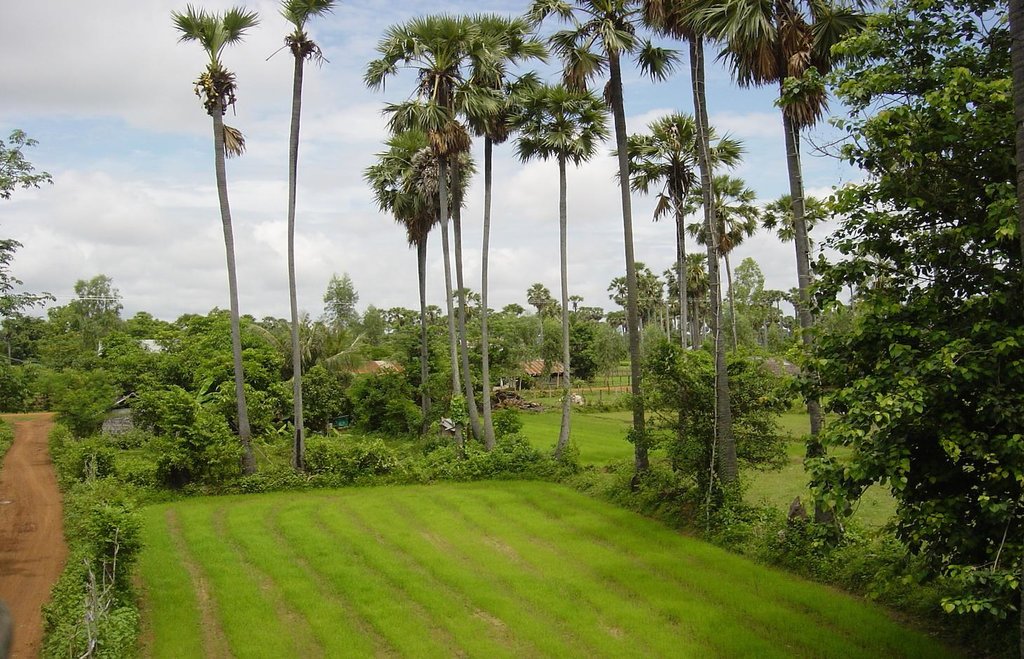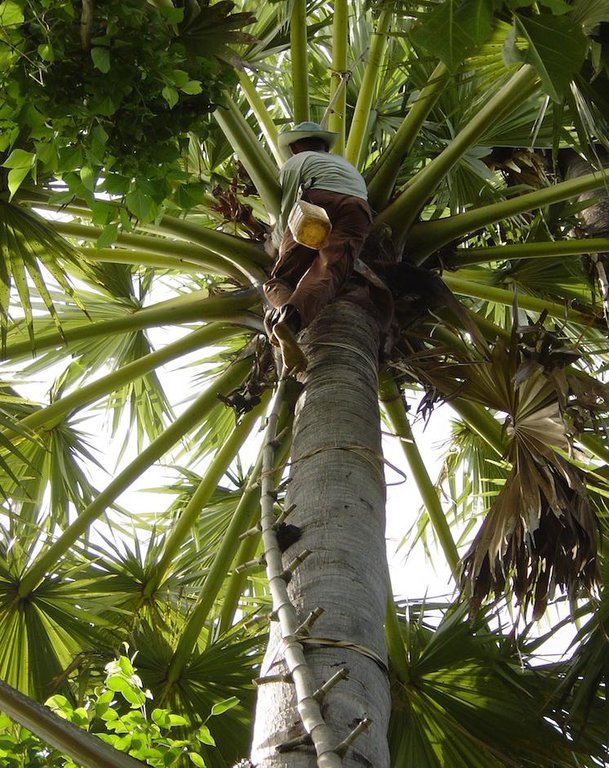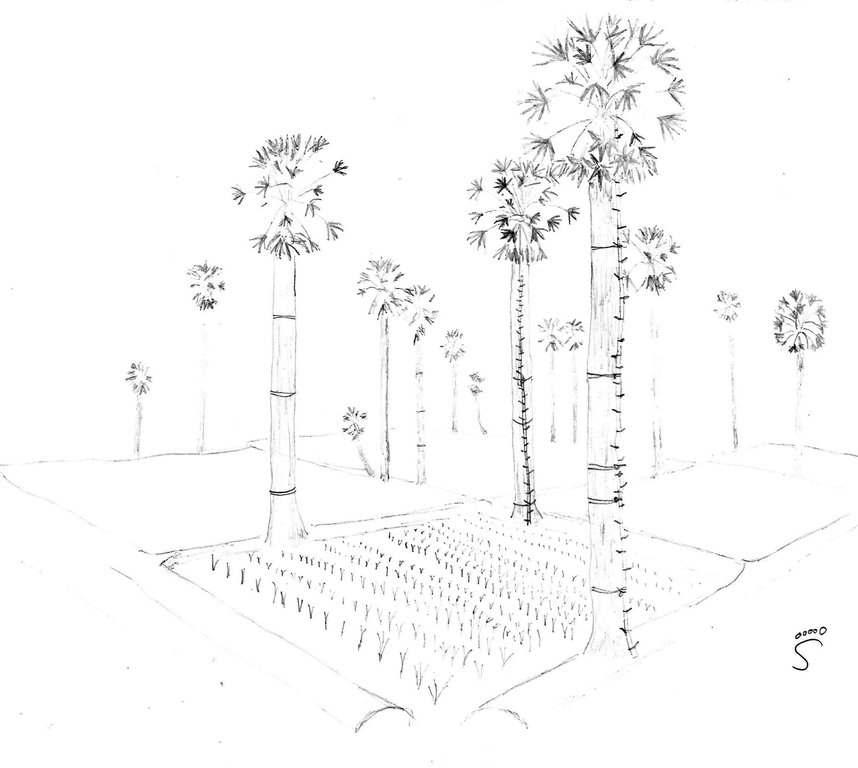Multipurpose use of sugar palm grown on rice field dykes. [Cambodia]
- Creation:
- Update:
- Compiler: Stefan Graf
- Editor: –
- Reviewers: Deborah Niggli, Alexandra Gavilano
ការប្រើប្រាស់ដើមតោ្នតដែលដំានៅតាមភ្លឺស្រែ (Khmer)
technologies_1629 - Cambodia
View sections
Expand all Collapse all1. General information
1.2 Contact details of resource persons and institutions involved in the assessment and documentation of the Technology
SLM specialist:
Khun Lean Hak
SOFDEC/LAREC, www.sofdec.com
1.3 Conditions regarding the use of data documented through WOCAT
The compiler and key resource person(s) accept the conditions regarding the use of data documented through WOCAT:
Ja
1.4 Declaration on sustainability of the described Technology
Is the Technology described here problematic with regard to land degradation, so that it cannot be declared a sustainable land management technology?
Nee
2. Description of the SLM Technology
2.1 Short description of the Technology
Definition of the Technology:
Sugar palms growing on the dykes along the rice fields are used as source of income and have different effects on the growing of the rice, like reducing the wind speed and thus the evaporation and wind erosion.
2.2 Detailed description of the Technology
Description:
The sugar palm (Borassus flabellifer ) is the national tree of Cambodia, it is well adapted to the local natural environment and there is a long tradition to grow sugar palms. Therefore, only a negligible workload is required for both the establishment (fruits falling down from the already existing trees will grow) and the maintenance of the trees. As the sugar palm is resistant to waterlogging and floods (even in flooded areas in the floodplains), and it grows well at low pH, it is planted/grown on the rice field dykes and around the houses. The trees which are growing around the paddy fields have some positive effects on both soil and rice, as they slow down the wind and thus reduce evaporation and wind erosion. They also attract wildlife, and thus allow the establishment of other vegetation. The trees also have a purifying effect on the groundwater, and cycle the nutrients which are otherwise lost in the groundwater. The sugar palms and their products can be used in manifold ways: the leaves for wickerwork and roofs; the stems as fences, for ropes and strings; the fruits as food, fodder and to make straw palatable for cattle; the sap as fodder, to make wine, sugar, and vinegar; and the trunk as construction wood – these are only some of its uses. They reduce the risk of a complete crop failure, as their products are not subject to weather fluctuations.
After the collectivization of land during the civil war (1975-1979), the land and the trees were newly distributed to the people according to the size of the household. The ownership of the land and of the trees was not related. Until today, the trees can be growing on someone’s land, but can be sold or rented to somebody else who harvests its products.
The main reason to plant sugar palms in this area is the sap collection. In order to collect the sap, firstly bamboo ladders are tied to the sugar palm trees. In the dry season, the tapper climbs up the trees to collect the sap. The male or female inflorescence is crushed with a special tool and a piece of it sliced off. Bottles are hanged beneath the cut part, and the sap will flow into these bottles. The crushing and slicing is repeated twice a day, so the amount of collected sap can be optimized. Most of the sap is cooked on a fire and made into syrup, and if there is too much sap, it is fermented and sold as palm wine.
The fruits that fall down on the rice fields are thrown on the dykes, where they grow. The seedlings tolerate some cattle grazing, as long as only the leaves and not the bud are eaten.
The analysed area is flat (slope < 2%), with a tropical climate (dry season from November to May and wet season from June to October), and the soils are mostly sandy or loamy. The soil has a low fertility, contains little organic matter, and acidifies. The area has been deforested a long time ago, and the groundwater table is rather high (1-2 m during the dry season, on the surface during wet season). Due to climate change, farmers notice more erratic rainfalls, temperature rises and more recurrent droughts. Rice is the predominant crop grown in the area, since it serves as staple food (mix subsistence and commercial activities).
The increasing migration rate (the young generation leaves the villages to work in the cities, garment industry or abroad) results in a decrease of available labour force in the area which has detrimental effects on the agricultural activities. Furthermore, the civil war in the 1970s (Khmer Rouge) led to the loss of agricultural knowledge which different NGOs try to re-establish.
2.3 Photos of the Technology
2.5 Country/ region/ locations where the Technology has been applied and which are covered by this assessment
Country:
Cambodia
Region/ State/ Province:
Kampong Chhnang
Further specification of location:
Rolear Bier / Thnorng Kombot
Specify the spread of the Technology:
- evenly spread over an area
If precise area is not known, indicate approximate area covered:
- 10-100 km2
Comments:
This technology is applied in most parts of Cambodia. Almost everywhere there are some sugar palms growing along the rice fields, but not in this density. The area mentioned is the area in the district where the technology is applied.
2.6 Date of implementation
If precise year is not known, indicate approximate date:
- more than 50 years ago (traditional)
2.7 Introduction of the Technology
Specify how the Technology was introduced:
- as part of a traditional system (> 50 years)
Comments (type of project, etc.):
It is a traditional tree in Cambodia, with historical use. Its introduction on the rice field dykes is unknown.
3. Classification of the SLM Technology
3.1 Main purpose(s) of the Technology
- improve production
- reduce, prevent, restore land degradation
3.2 Current land use type(s) where the Technology is applied
Land use mixed within the same land unit:
Ja
Specify mixed land use (crops/ grazing/ trees):
- Agroforestry

Cropland
- Annual cropping
- Tree and shrub cropping
- rice
- sugar palm
Number of growing seasons per year:
- 1
Specify:
Longest growing period in days: 210, Longest growing period from month to month: June-December
Comments:
Major land use problems (compiler’s opinion): Lack of organic matter, lack of water retention in soil, irregularity of rainfall, low soil fertility (sandy soil), monocultures, bare soil during dry season, ploughing, wind erosion and dust storms.
Major land use problems (land users’ perception): Soil fertility is low, rainfall is not secured in the beginning of the rainy season.
3.4 Water supply
Water supply for the land on which the Technology is applied:
- rainfed
3.5 SLM group to which the Technology belongs
- agroforestry
- windbreak/ shelterbelt
3.6 SLM measures comprising the Technology

vegetative measures
- V1: Tree and shrub cover
Comments:
Type of vegetative measures: aligned: -along boundary
3.7 Main types of land degradation addressed by the Technology

soil erosion by wind
- Et: loss of topsoil

chemical soil deterioration
- Cn: fertility decline and reduced organic matter content (not caused by erosion)

biological degradation
- Bh: loss of habitats
- Bs: quality and species composition/ diversity decline
Comments:
Main causes of degradation: soil management (Ploughing of the soil. Depending on the rainfall, sometimes the land is left bare for several days or weeks.), crop management (annual, perennial, tree/shrub) (Mainly rice is grown in monocultures.), over-exploitation of vegetation for domestic use (Straw is usually removed from the fields.), labour availability (Labour availability is low due to high migration rates (garment industry, drift to the cities, working abroad).)
Secondary causes of degradation: change in temperature (More hot days, the soil dries out faster.), droughts, education, access to knowledge and support services (Little knowledge about soil conservation.), war and conflicts (During the Khmer Rouge regime, a lot of agricultural knowledge got lost.)
3.8 Prevention, reduction, or restoration of land degradation
Specify the goal of the Technology with regard to land degradation:
- prevent land degradation
4. Technical specifications, implementation activities, inputs, and costs
4.1 Technical drawing of the Technology
Technical specifications (related to technical drawing):
Sugar palms (Borassus flabellifer) with bamboo ladders growing on the dikes around the rice fields.
Kampong Chhnang
Date: 2014
Technical knowledge required for field staff / advisors: low
Technical knowledge required for land users: low (They grow almost by themselves, as the fallen fruits are just thrown on the dykes as only management.)
Main technical functions: reduction in wind speed
Secondary technical functions: increase in nutrient availability (supply, recycling,…), increase / maintain water stored in soil
Aligned: -along boundary
Vegetative material: F : fruit trees / shrubs
Number of plants per (ha): 63
Vertical interval between rows / strips / blocks (m): 20
Vertical interval within rows / strips / blocks (m): 10
Fruit trees / shrubs species: Mostly naturally regenerated, but seeds are thrown on the dykes when they fall into the rice fields.
Author:
Stefan Graf, Switzerland
4.2 General information regarding the calculation of inputs and costs
Indicate average wage cost of hired labour per day:
5.00
4.3 Establishment activities
| Activity | Timing (season) | |
|---|---|---|
| 1. | Build a stove and buy pans to cook the sap into sugar. |
4.4 Costs and inputs needed for establishment
| Specify input | Unit | Quantity | Costs per Unit | Total costs per input | % of costs borne by land users | |
|---|---|---|---|---|---|---|
| Labour | Labour | ha | 1.0 | 10.0 | 10.0 | 100.0 |
| Equipment | machine use | ha | 1.0 | 25.0 | 25.0 | 100.0 |
| Total costs for establishment of the Technology | 35.0 | |||||
| Total costs for establishment of the Technology in USD | 35.0 | |||||
4.5 Maintenance/ recurrent activities
| Activity | Timing/ frequency | |
|---|---|---|
| 1. | Tie the bamboo ladders to the tree | |
| 2. | Collect the sap by pressing the inflorescence, cutting a slice off and putting a bottle underneath. | December-April, twice a day |
| 3. | Cook the sap to make sugar | Once or twice a day |
| 4. | Ferment the juice to make palm wine | If there's too much juice. |
4.6 Costs and inputs needed for maintenance/ recurrent activities (per year)
| Specify input | Unit | Quantity | Costs per Unit | Total costs per input | % of costs borne by land users | |
|---|---|---|---|---|---|---|
| Labour | Labour | ha | 1.0 | 3221.0 | 3221.0 | 100.0 |
| Construction material | Firewood | ha | 1.0 | 357.0 | 357.0 | 100.0 |
| Construction material | Bamboo and rattan | ha | 1.0 | 471.0 | 471.0 | 100.0 |
| Total costs for maintenance of the Technology | 4049.0 | |||||
| Total costs for maintenance of the Technology in USD | 4049.0 | |||||
Comments:
Machinery/ tools: Self-made crusher to induce a higher sap flow.
The costs were calculated with 44 trees (one unit), transformed into 62 trees per ha. The assessed farmer owns 0.35 ha of rice fields, with 22 trees on the dykes, but he bought additional trees on nearby dykes. The whole family is involved in the process.
The maintenance costs indicated above are that high because labour was calculated for each step. However, a big part of the work is done voluntarly by local land users and are not payed.
4.7 Most important factors affecting the costs
Describe the most determinate factors affecting the costs:
The factors affecting the costs are mainly the inputs (firewood, work to cook the sap to sugar) used to transform the sap into saleable products. They are not necessary to benefit from the positive effects of sugar palms on the microclimate and soil. To implement sugar palms on the rice field dikes the costs are negligible.
5. Natural and human environment
5.1 Climate
Annual rainfall
- < 250 mm
- 251-500 mm
- 501-750 mm
- 751-1,000 mm
- 1,001-1,500 mm
- 1,501-2,000 mm
- 2,001-3,000 mm
- 3,001-4,000 mm
- > 4,000 mm
Specifications/ comments on rainfall:
1486.45 mm 2013 in Kampong Chhnang
Agro-climatic zone
- sub-humid
Thermal climate class: tropics. 27-35°C
5.2 Topography
Slopes on average:
- flat (0-2%)
- gentle (3-5%)
- moderate (6-10%)
- rolling (11-15%)
- hilly (16-30%)
- steep (31-60%)
- very steep (>60%)
Landforms:
- plateau/plains
- ridges
- mountain slopes
- hill slopes
- footslopes
- valley floors
Altitudinal zone:
- 0-100 m a.s.l.
- 101-500 m a.s.l.
- 501-1,000 m a.s.l.
- 1,001-1,500 m a.s.l.
- 1,501-2,000 m a.s.l.
- 2,001-2,500 m a.s.l.
- 2,501-3,000 m a.s.l.
- 3,001-4,000 m a.s.l.
- > 4,000 m a.s.l.
5.3 Soils
Soil depth on average:
- very shallow (0-20 cm)
- shallow (21-50 cm)
- moderately deep (51-80 cm)
- deep (81-120 cm)
- very deep (> 120 cm)
Soil texture (topsoil):
- coarse/ light (sandy)
- medium (loamy, silty)
Topsoil organic matter:
- medium (1-3%)
- low (<1%)
5.4 Water availability and quality
Ground water table:
< 5 m
Availability of surface water:
poor/ none
Water quality (untreated):
poor drinking water (treatment required)
Comments and further specifications on water quality and quantity:
Ground water table: during dry season
Availability of surface water: during dry season
Drinking water: People use it for drinking after filtering or boiling.
5.5 Biodiversity
Species diversity:
- medium
5.6 Characteristics of land users applying the Technology
Market orientation of production system:
- mixed (subsistence/ commercial)
Off-farm income:
- 10-50% of all income
Relative level of wealth:
- poor
- average
Individuals or groups:
- individual/ household
Level of mechanization:
- manual work
Gender:
- women
- men
Indicate other relevant characteristics of the land users:
Land users applying the Technology are mainly common / average land users
Population density: 50-100 persons/km2
Annual population growth: 0.5% - 1%
Off-farm income specification: Handicraft, remittances, and factory work.
5.7 Average area of land used by land users applying the Technology
- < 0.5 ha
- 0.5-1 ha
- 1-2 ha
- 2-5 ha
- 5-15 ha
- 15-50 ha
- 50-100 ha
- 100-500 ha
- 500-1,000 ha
- 1,000-10,000 ha
- > 10,000 ha
Is this considered small-, medium- or large-scale (referring to local context)?
- small-scale
5.8 Land ownership, land use rights, and water use rights
Land ownership:
- communal/ village
- individual, not titled
Land use rights:
- communal (organized)
- individual
Water use rights:
- open access (unorganized)
Comments:
Land users have a title that is not recognized by the state. The trees sold by farmers to neighbours have a paper signed by the village chief to certify the ownership.
5.9 Access to services and infrastructure
health:
- poor
- moderate
- good
education:
- poor
- moderate
- good
technical assistance:
- poor
- moderate
- good
employment (e.g. off-farm):
- poor
- moderate
- good
markets:
- poor
- moderate
- good
energy:
- poor
- moderate
- good
roads and transport:
- poor
- moderate
- good
drinking water and sanitation:
- poor
- moderate
- good
financial services:
- poor
- moderate
- good
6. Impacts and concluding statements
6.1 On-site impacts the Technology has shown
Socio-economic impacts
Production
crop production
Comments/ specify:
Leaves fall on the fields, but if they are removed the adverse effect is negligible.
wood production
Comments/ specify:
Old trees are logged and used as firewood or construction material.
risk of production failure
Comments/ specify:
Sugar palms can grow in adverse conditions.
land management
Comments/ specify:
Trees on the dykes might hinder the use of machines on the fields.
Water availability and quality
drinking water availability
Comments/ specify:
Trees have a purifying effect on the water.
Income and costs
farm income
Comments/ specify:
The products of the sugar palms are sold on the market, whereas rice is only grown for sustenance.
diversity of income sources
Comments/ specify:
The products of the sugar palms are sold on the market, whereas rice is only grown for sustenance.
workload
Comments/ specify:
Harvesting and processing of sap is strenuous and time consuming, especially during dry season.
Socio-cultural impacts
health situation
Comments/ specify:
Cheap alcohol, diabetes
cultural opportunities
Comments/ specify:
Aesthetic value.
contribution to human well-being
Comments/ specify:
The products of the sugar palms generate income to the land user and his family (rice is only used for home consumption), and they are more resilient to erratic rainfall patterns.
Ecological impacts
Water cycle/ runoff
groundwater table/ aquifer
Comments/ specify:
The roots reach the ground water table, and have a difficult to quantify effect on it.
evaporation
Comments/ specify:
Evaporation is tackled due to the decrease of wind speed.
Soil
soil moisture
Comments/ specify:
Evaporation is tackled due to the decrease of wind speed.
nutrient cycling/ recharge
Comments/ specify:
Nutrients below the root level of annuals are picked up and reintroduced in the nutrient cycle.
Biodiversity: vegetation, animals
biomass/ above ground C
plant diversity
Comments/ specify:
The region is prone to monocultures (rice), however in this region there are a lot of sugar palms and other tree species. Sugar palms protect the other plants, attract birds (dissemination of seeds) and have therefore a positive impact on biodiversity.
animal diversity
Comments/ specify:
Sugar palms as habitat for different animals (bats, birds, etc.)
beneficial species
habitat diversity
Climate and disaster risk reduction
wind velocity
6.2 Off-site impacts the Technology has shown
groundwater/ river pollution
Comments/ specify:
Purifying effects of trees.
wind transported sediments
Comments/ specify:
Reduction of wind velocity.
Deforestation
Comments/ specify:
Firewood is used as the main source of energy. The land user buys the wood.
6.3 Exposure and sensitivity of the Technology to gradual climate change and climate-related extremes/ disasters (as perceived by land users)
Gradual climate change
Gradual climate change
| Season | increase or decrease | How does the Technology cope with it? | |
|---|---|---|---|
| annual temperature | increase | well |
Climate-related extremes (disasters)
Meteorological disasters
| How does the Technology cope with it? | |
|---|---|
| local rainstorm | well |
| local windstorm | well |
Climatological disasters
| How does the Technology cope with it? | |
|---|---|
| drought | well |
Hydrological disasters
| How does the Technology cope with it? | |
|---|---|
| general (river) flood | well |
Other climate-related consequences
Other climate-related consequences
| How does the Technology cope with it? | |
|---|---|
| reduced growing period | not well |
6.4 Cost-benefit analysis
How do the benefits compare with the maintenance/ recurrent costs (from land users' perspective)?
Long-term returns:
slightly positive
Comments:
Since it is a traditional technology, the initial costs cannot be estimated.
6.5 Adoption of the Technology
- > 50%
If available, quantify (no. of households and/ or area covered):
100% or 7 land user families
Of all those who have adopted the Technology, how many did so spontaneously, i.e. without receiving any material incentives/ payments?
- 91-100%
Comments:
The growing of sugar palms and its use for economic activities is a traditional technology.
100% of land user families have adopted the Technology without any external material support
7 land user families have adopted the Technology without any external material support
7 farmers produce sugar, however sugar palms are widely spread in this area. This is the reason why estimations are difficult to make.
6.7 Strengths/ advantages/ opportunities of the Technology
| Strengths/ advantages/ opportunities in the land user’s view |
|---|
| Many different uses of sugar palms, both for selling on the market and for home consumption (leaves, construction wood, fibre, sugar, wine, fruits, and vinegar). |
| Sugar palms protect the rice from the wind. |
| Strengths/ advantages/ opportunities in the compiler’s or other key resource person’s view |
|---|
| They slow down the wind, thus reduce evaporation, crop destruction and wind erosion. |
| Sugar palms are tolerant plants growing in adverse conditions like water logging, floods and droughts; they don’t need any care like fertilizer or pesticides. They produce anyway their useful products (Sap, leaves, stems) which can be transformed in many different ways (Sugar, wine, vinegar, house coverings, handicraft…) |
6.8 Weaknesses/ disadvantages/ risks of the Technology and ways of overcoming them
| Weaknesses/ disadvantages/ risks in the land user’s view | How can they be overcome? |
|---|---|
| Fallen palm leaves can hinder the rice growth on the fields. | Check the fields regularly and remove the fallen leaves. |
| Old trees can fall in storms and destroy a part of the crop. | Remove the oldest trees. |
| Weaknesses/ disadvantages/ risks in the compiler’s or other key resource person’s view | How can they be overcome? |
|---|---|
| Collecting sap is dangerous, especially when there is wind. | Use safety devices. |
| To make sugar, firewood is used, which induces deforestation. | As energy is needed in the dry season, solar energy could be used to boil the sap, with parabolic mirror cookers for example. |
| Plants producing a lot of sap are tapped more, thus produce no fruit, so no offspring. Only plants producing less sap will reproduce. | Select good producing trees and plant the selected seeds. |
| Because of the trees, mechanized farm operations on the rice fields are hindered. | Plant the trees in rows perpendicular to main wind, or long curved rice fields. |
| Only syrup can be made on farm, which is sold at a low price. | Organize in cooperatives to make sugar, which could get a better price. |
7. References and links
7.1 Methods/ sources of information
- field visits, field surveys
- interviews with land users
When were the data compiled (in the field)?
10/07/2014
7.2 References to available publications
Title, author, year, ISBN:
Borin, K. 1998. Sugar Palm (Borassus flabellifer): Potential feed source for livestock in small-scale farming systems. WAR 91
Available from where? Costs?
http://www.fao.org/docrep/w9980t/w9980T04.htm#TopOfPage (free)
Title, author, year, ISBN:
Feedipedia Sugar Palm (Borassus flabellifer)
Available from where? Costs?
http://www.feedipedia.org/node/178
Title, author, year, ISBN:
Johnson, D.V. 2010. Tropical Palms. FAO.
Available from where? Costs?
http://www.fao.org/docrep/012/i1590e/i1590e.pdf
Links and modules
Expand all Collapse allLinks
No links
Modules
No modules





